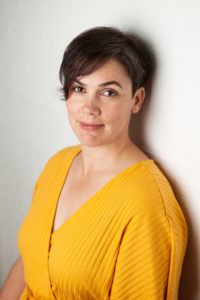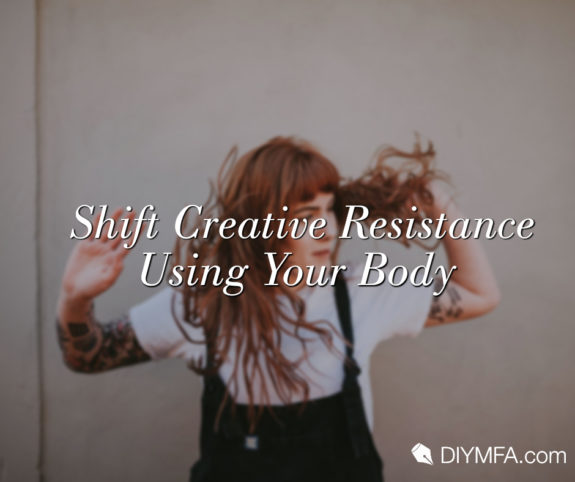Like me, I suspect one of the facets of creative resistance, aka writer’s block—overwhelm, perfectionism, procrastination, and self-doubt—has seduced you. You’ve probably cast about researching different tips and tricks on how to break free from resistance, so you can get back to writing.
Your research likely revealed tips on establishing better writing structures, getting ruthless with your time management, and just writing. All of this guidance is useful, but leaves out an important creative ally—our bodies.
The most effective tools I’ve got for shifting my resistance come from connecting with my body.
These tips, by the way, come from my experiences of creative resistance and writer’s block, and plenty of formal study and inner-work in the embodiment and somatic (body) realms. I have found that states of creative resistance have to do with whether our bodies feel settled and at ease, or whether they’re charged up and overwhelmed. In fact, if we’re holding a lot of stress in our bodies and nervous systems, it’ll express itself in ways that look a lot like writer’s block and creative resistance. If this is the case, the best way to shift your resistance is to tend to your body.
But why might our bodies be holding stress? When we encounter danger or a threat (even small ones that are over quickly, like close calls while crossing the street) our bodies react to protect us by engaging in a self-protective fight, flight, or freeze response. This is all very natural. Then, after the danger is over, if we get to discharge that response (often through “weird” responses like laughter, tears, shaking, fury, etc.) we go back to life, feeling fine.
However, if we don’t discharge our body’s danger response, we get stuck in a loop. In subtle ways, our bodies stay “on.” Always tense and ready to either bolt, argue, resist, or shut-down. If we get stuck in a loop, it becomes difficult to get into the flow of our creative work. Our bodies, which are still scanning for danger, are directing our attention towards safety and vigilance. Then we can go for years, even decades, feeling stuck.
As writers, these states of resistance are so distressing. We sit down with time carved out and good intentions, only to find ourselves shut down, not writing.
We don’t have to stay stuck though. Once we make our bodies our most trusted creative allies, we free up the energy that’s stuck and instead devote it to writing. But how? You’ll want to get intimate with how the states of overwhelm, perfectionism, procrastination, and self-doubt feel in your body, so you can identify what triggers and intensifies them.
Let’s explore these states and how they show up in your body, so you can shift them and write!
1. Ask
When you notice forms of creative resistance, ask how your body feels. Try to name physical sensations (without labeling them good or bad.)
For example, when I get overwhelmed, I notice piles of clutter build up. Overwhelm thinks like a squirrel, with scattered, sharp right turns in subject and topic. Overwhelm is, in my body, contraction and fatigue. I feel smaller, my vision feels darker and narrowed in. Overwhelm often makes it difficult to prioritize options and decide.
Perfectionism feels like I’m frozen in shame. I stop writing, feel immobilized, but, strangely, can do a lot of daydreaming, research, skill acquisition (so many workshops), and future planning (ie: researching all stages of the publication process before I’ve written over five pages.)
Procrastination feels like a pinch behind the eyes, a clenched heart, and escalating panic. My belly gets pressurized and I devote plenty of my energy to not doing my writing. I project roadblocks into the future.
Self-doubt feels like a clench in my guts. A swirling in my eyes. A sensation of smallness in my body.
The good news is it’s possible to gently and incrementally shift out of these resistance states. When you do, your creativity will flow with much more ease. No need to ever again be a tortured writer!
2. Pay Attention
Gently make friends with your body and pay attention.
Making friends with your body looks like asking yourself what sensation you’re feeling at any given moment. This is the key.
For example, if my mind spins and my apartment accumulates little piles of clutter, I know I’m in a state of overwhelm. This is my clue to pay attention.
I ask how my thoughts are. Spinning. Ok. I do a body scan and ask “What am I feeling in my body?” Because I know worry and overthinking makes my guts ache and bloat, I go straight there and ask how they are.
Guts, how are you doing? They say, “Yucky. Stop worrying so much, you’re making us hurt.” Ok. Got it. Anything else? Shoulders? Jaw? Back of the neck? How are you feeling? “Tight and tense.” Yeah, ok.
Well, I don’t like this somatic state I’m in. I better shift it, because I know from experience if I leave it, it’ll get worse and my writing will suffer.
3. Collect Tools
Create a collection of tools to shift your body responses so you can get unstuck and back to writing.
Then do them every time your body tells you it’s uncomfortable. Doing the body-based techniques is important. You can’t just read about it. It works because it’s experiential. Otherwise, you’ll increase your stress trying-to-figure-it-out in your head, over-researching, overthinking, seeking the big dramatic magic cure. Don’t avoid the gentle, consistent somatic practices that will truly move you out of creative resistance.
To get you started, here are some of my free somatic techniques:
- Tending to your breath. If you feel distressed, bring attention to your breathing and do ten in-out breaths, making sure your exhale is slightly longer than your inhale.
- Doing a simple two-minute O.M.G. exercise (orient, mobilize, ground.) Orient to the surrounding space by letting your gaze land on a tangible physical object, then name three specific, non-abstract details about it. (Repeat two more times.) Mobilize by wiggling your fingers and toes and noticing sensation. Ground by sending your attention to your sit bones and feet, then follow the pull of gravity, with your imagination, into the earth.
- Giving yourself a friendly hug/squeeze. Firmly grasp your arms or legs in your hands and squeeze with solid pressure for a couple minutes.
- Body-oiling. Just google “body-oiling + nervous system.”
- Dancing. Letting your body move to music helps bounce and shake the resistance out.
- 20 minutes of walking. Without trying to be productive or using audio, just roam. Notice your surroundings and settle into the rhythmic movement.
- Any kind of handwork (drawing, woodwork, pottery, knitting, weaving, sewing, embroidery, cutting/chopping/cooking, etcetera.) The rhythmic repetitive movements inherent to handwork helps shift creative resistance.
- Eating healthy fats and proteins. It grounds and settles your body.
- Setting a timer for 10+ minutes and flow-writing (by hand).
All you need to do as you develop your list of getting-unstuck tools is pick the something on your list, and do it. No ifs, ands, or buts.
Because if all we do is cultivate self-awareness without building a toolkit of ways to move our awareness into tangible change, we’ll trap ourselves in the uncomfortable state (yes, I’ve been here too) of seeing, with exquisite clarity, how we’re blocked, without being able to change it.
A bonus of making our bodies our most trusted creative allies? We develop an expressive somatic (body-based) vocabulary. It becomes easier to describe our character’s physical experiences and articulate them, because we’re in touch with our body.
Last step?
Repeat the process when you feel resistance creeping back in.

Janelle Hardy is a writer, artist, host of the Personal Mythmaking Podcast and the creator/teacher of a transformational memoir-writing course called The Art of Personal Mythmaking. She’s been working as a trauma-informed bodyworker in the hands-on healing arts fields for 13+ years and as an artist (writing, painting + dance) for 17+ years. Throughout that time she’s taught adults out of her living room, arts centers, universities and community colleges. For the past 5+ years she’s integrated all of her expertise, including a BA in Anthropology, an MA in Dance and a Diploma in Structural Integration, into supporting people in their creative healing work via the alchemy of transformational memoir-writing.







